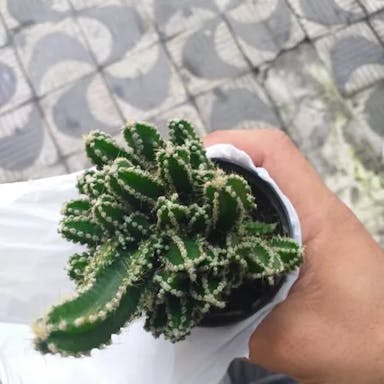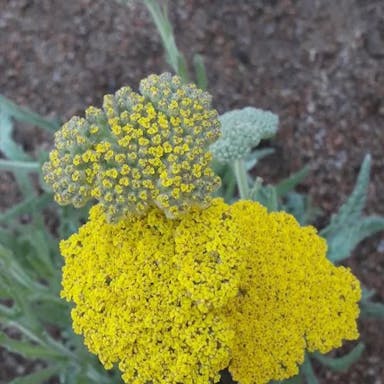Every two sentences have line breaks. The usual flower language used for Turkish sage in America has: - Experience - Value - Physical wellness A usual illustration is: - Experience: Since Turkish sage has been used traditionally in medicine and cooking, it represents awareness, understanding, and smarts. Flowers for birthdays: - Not applicable
Turkish sage
- Scientific name
- Phlomis russeliana
Basic Information
- Lamiaceae Family Phlomis Genus Turkish sage Species
- Lamiaceae > Phlomis > Phlomis russeliana
- 67%
- The Completeness of This Encyclopedia
Please help us complete the encyclopedia, Terrarium is a encyclopedia service to be completed with everyone in the world. Currently, this page is 67% complete. For more information on how to contribute, please click here.
- Perennial
- Subshrub
- Height
- 100cm ~
- Flower Color
- Leaf Color
- Anthesis
- summer
- Sunlight Exposure
Full Sun Long hours of sunlight from morning to afternoon Partial Shade A location in the shade of a tree or where either the morning or afternoon is shaded Full Shade A place where there is no direct sunlight
- Full Sun
- Hardiness Zones
This is an indicator to know to which zone each plant can winter. Knowing the zone of each plant gives you an idea of the cold temperature resistance when grown in the ground without a roof. 2: -42.7 to -40.0 3: -39.9 to -34.4 4: -34.3 to -28.9 5: -28.8 to -23.3 6: -23.2 to -17.8 7: -17.7 to -12.2 8: -12.1 to -6.7 9: -6.6 to -1.1 10: -1.0 to 4.4 11: 4.5 to 10.0
- 4
- Cold resistance
- Excellent
- Heat resistance
- Good
- Habitat of origin
- Turkey, Syria
- Growth Rate
- Normal
What is Turkish sage (Phlomis russeliana)?
What is Turkish sage (Phlomis russeliana)
NO DATA
Flower meaning
Calendar of Turkish sage (Phlomis russeliana)
Calendar
Turkish sage in the United States typically blooms from late spring to early summer. The flowers are best in June. Blooming happens once a year, lasting around 3-4 weeks. To make the blooming time longer, remove faded flowers often. Also, well-drained soil and lots of sunlight can help longer blooming. Keeping the soil evenly moist is very important for the flowers to grow well. Turkish sage brings in pollinators like bees and butterflies, improving the garden.
How to grow Turkish sage (Phlomis russeliana)
Watering
For the Turkish sage. The watering frequency depends on time. In spring and summer, provide deep water once every 7-10 days. Keep the soil moist, not soaked. In winter, reduce watering to once every 2-3 weeks when the plant is dormant. Adjust water based on soil dryness. Water more if the soil dries fast. Use well-drained soil to prevent waterlogging. Water at the base to avoid wet leaves, which can cause disease. Watch the plant's response to water to adjust the plan.
Soil and Fertilizer
Turkish sage flourishes in properly drained topsoil with a pH range between 6.5 and 7.5. This plant favors sandy to loamy land that contains abundant organic matter. Apply even fertilizer, for example a 10-10-10 recipe, at first of spring preceding new expansion emerges. Dispense the fertilizer at a ratio of 1 pound per 100 quadrangle feet of growing site. Throughout the farming season, a water-soluble fertilizer can be applied every 4-6 weeks to endorse hardy increase. Refrain over-nourishing, as excess could generate too much leafage expansion in place of flower making. On a regular basis examine the dirt grade and conform the fertilizing timetable accordingly. Blank line. Cheerful calla flowers with lustrous foliage. Delightful as a houseplant or cut bloom. Originated in marshes so keep humid. Gorgeous in mixed containers. Height 24-30 inches. Zones 9-11 outdoors.
Sunlight and Place
Turkish sage blooms in full exposure to the sun. It requires a minimum of 6 to 8 hours of sunlight daily. The plant tolerates high temperatures well, preferring 60-80°F (15-27°C). The sage can handle cold to 20°F (-6°C) but extra protection in harsh winters helps. Water adequately in summer to prevent drying out. Cut back on watering frequency in winter to avoid soggy soil. Good drainage prevents root rot. Morning and early afternoon sun is essential for the plant. This allows optimal photosynthesis.
Advanced Information of Turkish sage (Phlomis russeliana)
Pruning
Turkish sage needs regular trimming to keep its form, stimulate new growth, and improve blooming. The optimal time to trim is early spring before new growth starts. Trimming should be done by removing stems to just over a collection of leaves or a node to encourage bushy development. After trimming, eliminate any dead, damaged, or infected branches to develop the whole health of the plant. Stay away from heavy trimming in late fall or winter to stop frost damage to new growth. Frequent trimming will assist Turkish sage to grow and continue healthy year after year. Financial development plays a significant role in poverty reduction. However, not all paths to financial development equally benefit the poor. Some paths benefit the rich more, further increasing inequality. Disparities in access to finance, technology, land, infrastructure and education prevent the poor from fully participating in growth processes, and lead to weaker poverty-reducing effects. Understanding these differences, and their implications for policy, is essential for accelerating poverty reduction. The evidence on these issues is less developed than the literature on the impacts of macroeconomic performance and growth on poverty and inequality. Clearly, more research is needed on these important issues.
Planting and Harvest
Turkish sage grows best when planted in drained soil that is slightly acidic to neutral. The container should have holes in the bottom so extra water can escape. Put this plant where it gets full sun. When you first plant it, carefully loosen the roots. Put the plant at the same depth in the new pot as it was in the nursery pot. Fill in around it with soil and gently press down. Every 2 or 3 springs, move it to a somewhat bigger pot. Lightly mist it sometimes for moisture. Be careful not to overwater, which can cause root rot.
Propagation
Turkish sage should be promoted through sowing seeds, for division, and leaf cutting. The seeds require well-draining soil, kept moist, and put in a sunny and warm place. To divide involves separating plants in full growth into small sections, making sure each section includes roots attached. Leaf cutting can also be utilized by taking a sound leaf, situating it in a humid growing medium until roots form up. To guarantee useful propagation, it is encouraged to make use of a union of methods to increase the opportunities of success.
Pests and Diseases
NO DATA
Habitat of Turkish sage (Phlomis russeliana)
Habitat
Toxicity of Turkish sage (Phlomis russeliana)
Health Benefits
- edible
- Inedible
- Toxic
- No toxicity
NO DATA
Toxic for dogs and cats
NO DATA
Q&A of Turkish sage (Phlomis russeliana)
- Where can I find reliable suppliers of Turkish sage seeds for my herb garden?
Reliable suppliers of Turkish sage seeds, scientifically known as Phlomis russeliana, can be found through various online platforms such as Amazon, eBay, and specialized gardening websites like Eden Brothers or Plant World Seeds. These online stores provide many kinds of seeds. It is important to check the seller's ratings and reviews to be sure of the quality and realness of the seeds. Also, local plant stores or botanical gardens may have Turkish sage seeds, mainly those that focus on herb and Mediterranean plants.
- Is there a recommended way to choose?
Turkish sage has two main types: 'Alba' and 'Edward Bowles'. 'Alba' has white flowers and silver-green leaves, while 'Edward Bowles' has yellow flowers and grey-green leaves. When picking seeds, choose plump, firm ones without damage. For seedlings, select those with healthy, bright green leaves and strong stems. Make sure the roots are well-grown and not root-bound. It is important to buy from trusted sellers to ensure the quality and realness of the Turkish sage types. Do research on the needs of each type to ensure good growth and development. One line break. Foliage of 'Alba' cultivar exhibits silvery green, whereas 'Edward Bowles' displays grayish green leaves. White blooms characterize the former, while yellow flowers typify the latter. Undamaged, plump seeds recommended over shriveled ones. Vigorous leaf growth and sturdy stem structure desirable traits when choosing starter plants. Well-developed root system critical, avoid root-bound specimens. Reputability of supplier key to authenticity of varieties. Individual cultural requirements of each cultivar should be investigated.
- What are the culinary and medicinal uses of Turkish sage in various cultures?
Turkish sage, the scientific name Phlomis russeliana, is used in different cultures for cooking and medicine. For cooking, the leaves have a unique, bitter taste. They add flavor to foods. For health, it has anti-inflammatory and antimicrobial properties. It has traditionally helped with digestive problems, breathing issues, and skin conditions. Also, the roots are used in traditional Chinese medicine for fever and cough symptoms.












